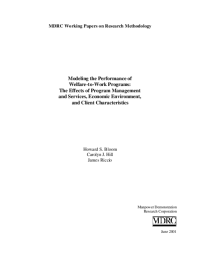Modeling the Performance of Welfare-to-Work Programs
The Effects of Program Management and Services, Economic Environment, and Client Characteristics
This paper addresses a question of direct relevance to welfare administrators and program operators: What management practices, program strategies, and local conditions are key to running effective welfare-to-work programs? Based on rigorous studies of the impacts and implementation of programs operating in 59 sites, the paper finds that clients' two-year earnings increase more when programs emphasize employment, provide personalized attention, and do not allow staff caseloads to become large. The findings also indicate that programs that operate in areas where unemployment is high have a smaller impact on short-term earnings than programs in other areas.






